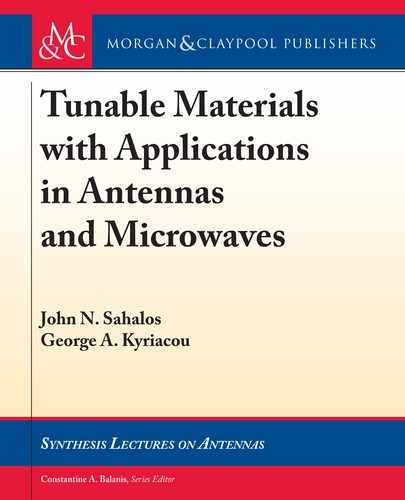
4.3. TOPOLOGIES—CONNECTIVITY AT TWO–PHASE COMPOSITES 175
built composites and their connectivity are illustrated in Figure 4.2 as: (a) spherical particles,
(b) laminate composite, and (c) fiber/rod inclusions. Usually, materials such as BaTiO
3
, PZT
(Terfenol-D ceramic), piezoelectric polymer [PCVDF_TrFE], and Pb(MgNb)O
3
–PbTiO
3
are
utilized for the matrix ferroelectric/piezoelectric phase, while ferrites—often nickel (Ni), lithium
(Li) or YIG for the magnetic phase—comprise the particles inclusions [1].
(a)
(b)
(c)
Figure 4.2: ree usual multiferroic composites: (a) spherical particles, (b) laminate composite,
and (c) fiber/rod inclusions.
e laminate composite (Figure 4.2b) is also referred to as layered multiferroic het-
erostructure of alternating layers of ferroelectric and magnetic thin films. In [6], there were
magnetite/lead-zirconium-titanate (Fe
3
O
4
/P2T) and lead-magnesium niobate-lead titanate
(Fe
3
O
4
/PMN-PT) multiferroic heterostructures employed. Also reported was an electrostat-
ically tunable ferromagnetic resonance (FMR) field shift of up to 600 Oe, corresponding to a
microwave ME coefficient of 670 Oe/(kV/cm).

176 4. MULTIFERROICS: FERRITE–FERROELECTRIC COMPOSITES
4.4 MULTIFERROICS CONSTITUTIVE RELATIONS
e design of any microwave device is based on an initial estimation of the geometry-topology.
An accurate simulation up to its final layout form, ready for fabrication, follows this. Devices
involving ordinary media are based on electromagnetic simulations requiring the constitutive re-
lations between electric and magnetic-field displacement/induction and the corresponding field
intensities. However, when multiferroics are incorporated, the mechanical/elasticity problem
must be solved in parallel with the electromagnetic one. In other words, the simulation corre-
sponds to the solution of a multi-physics problem. e involved constitutive relations read [1]:
D D eS C "E CaH (4.4a)
B D qS C a
T
E C H (4.4b)
D cS e
T
E C H : (4.4c)
e vector-field quantities are devoted as stress and strain S , electric field displacement
(D
), intensity
.E/
, magnetic field induction (
B
), and intensity (
H
). Correspondingly, the con-
stitutive parameters are the stiffness .c/, electric permittivity ("), magnetic permeability (),
piezoelectric coefficient .e/, piezomagnetic coefficient .q/, and ME coefficient .a/. For a better
understanding of the magnetoelectric effects, scientists employ the expansion of the free-energy
functional system-Hamiltonian [4–7] as:
F
E; H
D F
o
P
S
i
E
i
M
S
i
H
i
1
2
"
o
"
ij
E
i
E
j
1
2
o
ij
H
i
H
j
1
2
ˇ
ijk
E
i
H
j
H
k
1
2
ijk
H
i
E
j
H
k
: : : (4.5)
e differentiation of the energy functional (Hamiltonian) with respect to the applied
microwave electric field intensity yields the electric polarization:
P
i
E; H
D
@F
@E
i
D P
S
i
C "
o
"
ij
E
j
C a
ij
H
i
C
1
2
ˇ
ijk
H
j
H
k
C
ijk
H
i
E
j
: : : (4.6a)
Likewise, the differentiation with respect to the applied magnetic-field intensity (H
i
)
yields the magnetization:
M
i
E; H
D
@F
@H
i
D M
S
i
C
o
ij
H
j
C a
ij
E
i
C ˇ
ijk
E
i
H
j
C
1
2
ijk
E
j
E
k
: : : (4.6b)
..................Content has been hidden....................
You can't read the all page of ebook, please click here login for view all page.
